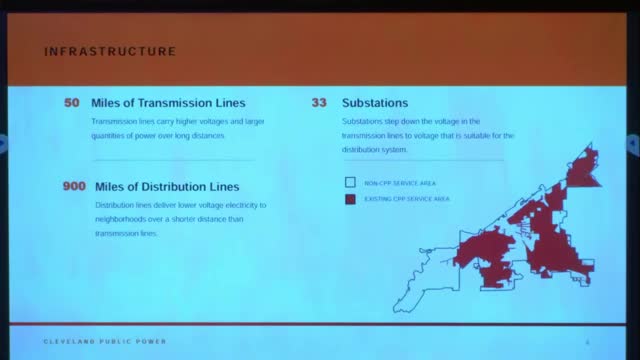Power Grid Upgrades Face Soaring Replacement Costs
September 20, 2024 | Cleveland, Cuyahoga County, Ohio
This article was created by AI summarizing key points discussed. AI makes mistakes, so for full details and context, please refer to the video of the full meeting. Please report any errors so we can fix them. Report an error »

During a recent government meeting, officials highlighted the critical importance and rising costs associated with the region's electrical infrastructure, particularly the 138 kV transmission lines and substations. These transmission lines are deemed essential for enhancing system reliability and redundancy, ultimately improving the ability to deliver power to communities. However, the financial burden of maintaining and replacing this infrastructure is significant, with a conservative estimate placing the cost of replacing each mile of transmission line at approximately $2 million.
The discussion also focused on the aging substations that serve as vital hubs within the electrical network. Currently, there are 33 substations in operation, and the costs associated with their replacement have escalated dramatically. An example was shared from a municipal peer who replaced a high-voltage substation 10 to 15 years ago for $5 million. Today, the cost for a new substation has surged to $16 million, reflecting broader trends in infrastructure expenses.
Additionally, the meeting addressed the presence of 24 10 kV substations, which utilize older voltage technology that is becoming increasingly obsolete. Despite their outdated nature, these substations remain necessary for the current grid operations, underscoring the challenges faced in modernizing the electrical infrastructure while managing escalating costs. The discussions signal a pressing need for strategic planning and investment to ensure the reliability and efficiency of the power supply in the region.
The discussion also focused on the aging substations that serve as vital hubs within the electrical network. Currently, there are 33 substations in operation, and the costs associated with their replacement have escalated dramatically. An example was shared from a municipal peer who replaced a high-voltage substation 10 to 15 years ago for $5 million. Today, the cost for a new substation has surged to $16 million, reflecting broader trends in infrastructure expenses.
Additionally, the meeting addressed the presence of 24 10 kV substations, which utilize older voltage technology that is becoming increasingly obsolete. Despite their outdated nature, these substations remain necessary for the current grid operations, underscoring the challenges faced in modernizing the electrical infrastructure while managing escalating costs. The discussions signal a pressing need for strategic planning and investment to ensure the reliability and efficiency of the power supply in the region.
View full meeting
This article is based on a recent meeting—watch the full video and explore the complete transcript for deeper insights into the discussion.
View full meeting
